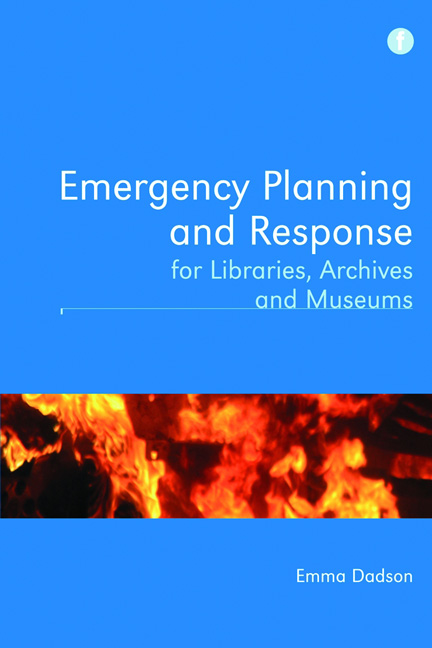Book contents
- Frontmatter
- Contents
- Foreword
- Preface
- Acknowledgements
- 1 Introduction
- 2 Case studies
- 3 Roles and responsibilities
- 4 Incident control
- 5 Planning the recovery operation
- 6 Collections salvage
- 7 Supplementary content
- 8 Dealing with the building
- 9 Business continuity
- 10 Ensuring the plan's efficacy
- 11 Conclusion
- Bibliography and references
- Index
- Frontmatter
- Contents
- Foreword
- Preface
- Acknowledgements
- 1 Introduction
- 2 Case studies
- 3 Roles and responsibilities
- 4 Incident control
- 5 Planning the recovery operation
- 6 Collections salvage
- 7 Supplementary content
- 8 Dealing with the building
- 9 Business continuity
- 10 Ensuring the plan's efficacy
- 11 Conclusion
- Bibliography and references
- Index
Summary
Planning salvage
With the situation now under control and the quantity of damage known, and safety assessed and managed, the salvage operation can begin to recover the affected items and attempt to repair the damage they have sustained.
Averting secondary damage
The objective of the salvage operation is to rectify the initial damage but also to avert secondary damage to affected materials. Secondary damage results from the primary damage (the water, fire or smoke) and gets worse over time. Early intervention can prevent it from occurring. After domestic fires, one of the first actions insurers require is the cleaning of laminated work surfaces and uPVC windows. If they are left with smoke covering them for a protracted period, discolouration occurs, and they need to be replaced, which is an avoidable extra cost. Simple cleaning with a detergent will avoid this costly secondary damage.
In the context of heritage and information services collections, secondary damage is more likely to take the form of mould growth, corrosion, warping and distortion, and an overall weakening of the strength of an item such as a bound volume (e.g. as glues become loose in the presence of water). After the primary damage, secondary damage usually starts to escalate rapidly from 48–72 hours after the damage initially occurred and the waters receded. Secondary damage, which is avoidable if salvage begins early enough, adds extensively to the timescale and complexity of restoration as additional processes need to be applied. It is usually reversible, but at an additional cost. In the case of mould growth, the cost and rate of the recovery process are increased, as additional safety equipment should be worn by salvage volunteers, and mouldy items need to be isolated in polythene bags, which involves additional processes and adds to the timescale. Avoidable staining will also occur, which is costly to rectify, and the damaged items will also need to be sanitized to eradicate any residual growth after drying. These additional processes can be avoided completely if the items are salvaged before mould growth commences.
- Type
- Chapter
- Information
- Publisher: FacetPrint publication year: 2012



